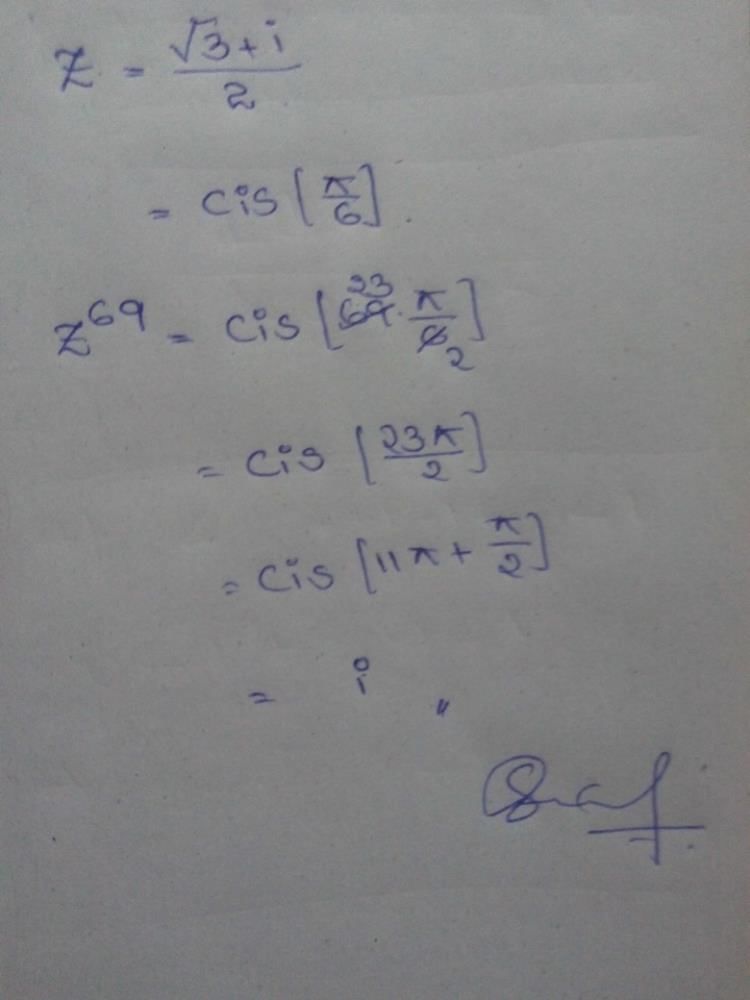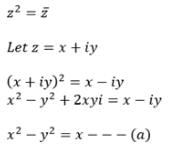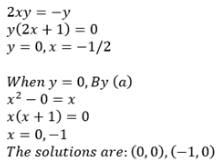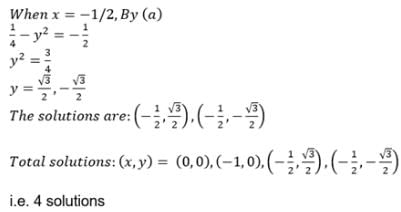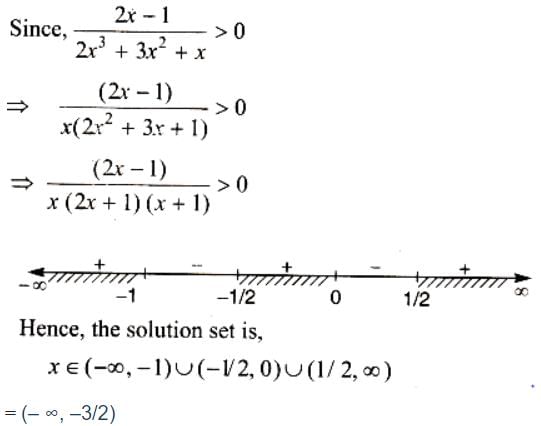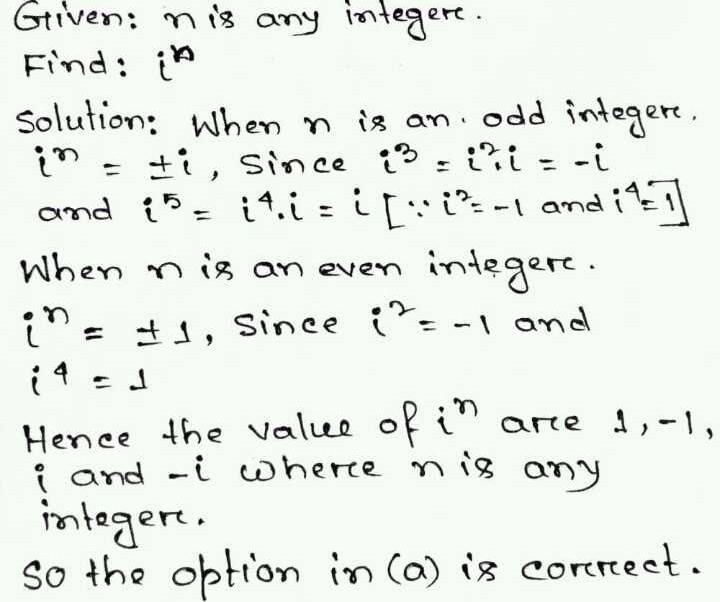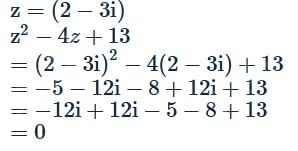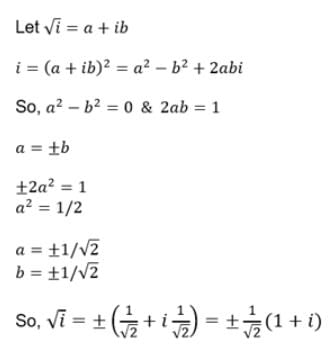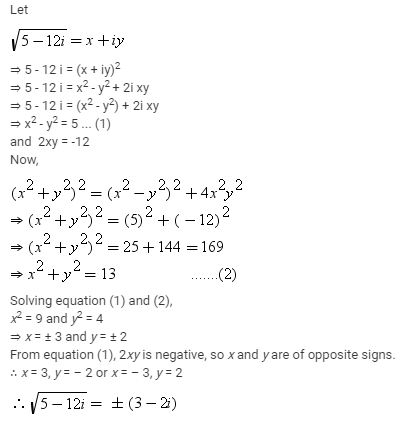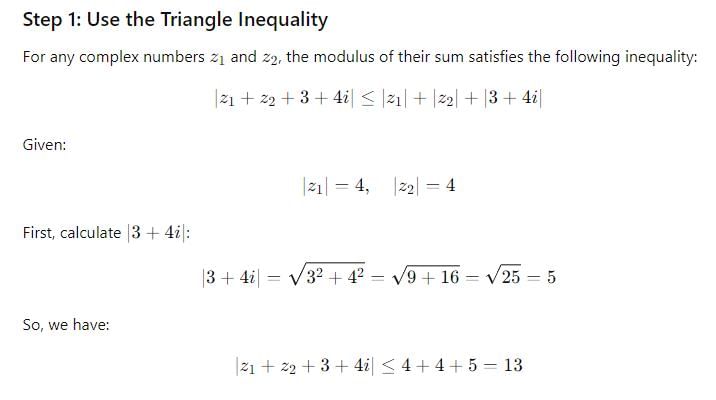All Exams >
Commerce >
Mathematics (Maths) Class 11 >
All Questions
All questions of Complex Numbers & Quadratic Equations for Commerce Exam
Imaginary part of −i(3i + 2) isa)−2b)2c)3d)−3Correct answer is option 'A'. Can you explain this answer?
|
|
Geetika Shah answered |
(-i)(3i) +2(-i) =-3(i^2)-2i =-3(-1)-2i =3-2i since i=√-1 =3+(-2)i comparing with a+bi,we get b=(-2)
Write in the simplest form: (i)-997- a)-i
- b)1
- c)-1
- d)i
Correct answer is 'A'. Can you explain this answer?
Write in the simplest form: (i)-997
a)
-i
b)
1
c)
-1
d)
i

|
Muskaan Mishra answered |
I^-997= 1/i^997, 1/(i^4)^249 × i, since i^4 = 1, i^4/i= i^3= -i
Find the reciprocal (or multiplicative inverse) of -2 + 5i - a)

- b)

- c)

- d)

Correct answer is option 'A'. Can you explain this answer?
Find the reciprocal (or multiplicative inverse) of -2 + 5i
a)
b)
c)
d)
|
|
Gaurav Kumar answered |
-2 + 5i
multiplicative inverse of -2 + 5i is
1/(-2+5i)
= 1/(-2+5i) * ((-2-5i)/(-2-5i))
= -2-5i/(-2)^2 -(5i)^2
= -2-5i/4-(-25)
= -2-5i/4+25
= -2-5i/29
= -2/29 -5i/29
multiplicative inverse of -2 + 5i is
1/(-2+5i)
= 1/(-2+5i) * ((-2-5i)/(-2-5i))
= -2-5i/(-2)^2 -(5i)^2
= -2-5i/4-(-25)
= -2-5i/4+25
= -2-5i/29
= -2/29 -5i/29

- a)

- b)

- c)

- d)

Correct answer is option 'C'. Can you explain this answer?
a)
b)
c)
d)

|
Lohit Matani answered |
(x+iy)(x−iy) = (a+ib)(a−ib)/(c+id)(c−id)
⇒x2−iy2 = √[(a2−i2b2)/(c2−i2d2)]
⇒x2+y2 = √[(a2+b2)/(c2+d2)] [1i2 = -1]
(x2+y2)2 = (a2+b2)/(c2+d2)
⇒x2−iy2 = √[(a2−i2b2)/(c2−i2d2)]
⇒x2+y2 = √[(a2+b2)/(c2+d2)] [1i2 = -1]
(x2+y2)2 = (a2+b2)/(c2+d2)
Find the real numbers x and y such that : (x + iy)(3 + 2i) = 1 + i- a)

- b)

- c)

- d)

Correct answer is option 'A'. Can you explain this answer?
Find the real numbers x and y such that : (x + iy)(3 + 2i) = 1 + i
a)
b)
c)
d)
|
|
Suresh Iyer answered |
(x + iy)(3 + 2i) = (1 + i)
x + iy = (1 + i)/(3 + 2i)
x + iy = [(1 + i) * (3 - 2i)] / [(3 + 2i)*(3 - 2i)]
x + iy = (3 + 3i - 2i + 2) / [(3)2 + (2)2]
x + iy = (5 + i)/[ 9 + 4]
= (5 + i) / 13
=> 13x + 13iy = 5+i
13x = 5 13y = 1
x = 5/13 y = 1/13
x + iy = (1 + i)/(3 + 2i)
x + iy = [(1 + i) * (3 - 2i)] / [(3 + 2i)*(3 - 2i)]
x + iy = (3 + 3i - 2i + 2) / [(3)2 + (2)2]
x + iy = (5 + i)/[ 9 + 4]
= (5 + i) / 13
=> 13x + 13iy = 5+i
13x = 5 13y = 1
x = 5/13 y = 1/13
Express the following in standard form : 
- a)3+3i
- b)2 + 2i
- c)1 + 2i
- d)0 + 2i
Correct answer is option 'D'. Can you explain this answer?
Express the following in standard form : 
a)
3+3i
b)
2 + 2i
c)
1 + 2i
d)
0 + 2i
|
|
Gaurav Kumar answered |
(8 - 4i) - (-2 - 3i) + (-10 + 3i)
=> 8 - 4i + 2 + 3i-10 + 3i
=> 8 + 2 - 10 - 4i + 3i + 3i =>0 + 2i
=> 8 - 4i + 2 + 3i-10 + 3i
=> 8 + 2 - 10 - 4i + 3i + 3i =>0 + 2i
Find the real numbers x and y such that :a) b)
b) c)
c) d)
d) Correct answer is option 'c'. Can you explain this answer?
Correct answer is option 'c'. Can you explain this answer?
|
|
Hansa Sharma answered |
(x + iy) (3 + 2i)
= 3x + 2xi + 3iy + 3i*y = 1+i
= 3x-2y + i(2x+3y) = 1+i
= 3x-2y-1 = 0 ; 2x + 3y -1 = 0
on equating real and imaginary parts on both sides
on solving two equations
x= 5/13 ; y = 1/13
= 3x + 2xi + 3iy + 3i*y = 1+i
= 3x-2y + i(2x+3y) = 1+i
= 3x-2y-1 = 0 ; 2x + 3y -1 = 0
on equating real and imaginary parts on both sides
on solving two equations
x= 5/13 ; y = 1/13
If If ω is a non real cube root of unity and (1+ω)9 = a+bω;a,b ∈ R, then a and b are respectively the numbers :- a)1, 0
- b)-1, 0
- c)0, 1
- d)0, -1
Correct answer is option 'B'. Can you explain this answer?
If If ω is a non real cube root of unity and (1+ω)9 = a+bω;a,b ∈ R, then a and b are respectively the numbers :
a)
1, 0
b)
-1, 0
c)
0, 1
d)
0, -1
|
|
Aryan Khanna answered |
Since w is the cube root of unity.
(1+w)9 =A+Bw
⇒(−w2)9 =A+Bw
⇒−(w3)6 = A+Bw
⇒−1=A+Bw
∴ A= -1 & B=0
(1+w)9 =A+Bw
⇒(−w2)9 =A+Bw
⇒−(w3)6 = A+Bw
⇒−1=A+Bw
∴ A= -1 & B=0

- a)

- b)

- c)

- d)

Correct answer is option 'C'. Can you explain this answer?
a)
b)
c)
d)

|
Manish Aggarwal answered |
(a + ib)1/2 = (x + iy)
Squaring both sides,
a + ib = (x + iy)2
a + ib = x2 - y2 + 2ixy
Equating real and imaginary
a = x2 - y2 b = 2xy............(1)
Using (x2 + y2)2 = (x2 - y2)2 + 4xy
(x2 + y2)2 = a2 + b2
(x2 + y2) = (a2 + b2)1/2.......(2)
Adding (1) and (2)
2x2 = (a2 + b2)1/2 + a
x = +-{1/2(a2 + b2)1/2 + a}1/2
Subtract (2) from (1)
2y2 = (a2 + b2)1/2 - a
y = x = +-{1/2(a2 + b2)1/2 - a}1/2
Therefore, (a+ib)1/2 = x+iy
=> +-{1/2(a2 + b2)1/2 + a}1/2 + i+-{1/2(a2 + b2)1/2 - a}1/2
Squaring both sides,
a + ib = (x + iy)2
a + ib = x2 - y2 + 2ixy
Equating real and imaginary
a = x2 - y2 b = 2xy............(1)
Using (x2 + y2)2 = (x2 - y2)2 + 4xy
(x2 + y2)2 = a2 + b2
(x2 + y2) = (a2 + b2)1/2.......(2)
Adding (1) and (2)
2x2 = (a2 + b2)1/2 + a
x = +-{1/2(a2 + b2)1/2 + a}1/2
Subtract (2) from (1)
2y2 = (a2 + b2)1/2 - a
y = x = +-{1/2(a2 + b2)1/2 - a}1/2
Therefore, (a+ib)1/2 = x+iy
=> +-{1/2(a2 + b2)1/2 + a}1/2 + i+-{1/2(a2 + b2)1/2 - a}1/2

- a)10
- b)4
- c)8
- d)6
Correct answer is option 'D'. Can you explain this answer?
a)
10
b)
4
c)
8
d)
6

|
Ciel Knowledge answered |
Let √(5 – 12i) = x + iy
Squaring both sides, we get
5 – 12i = x2 + 2ixy +(iy)2 = x2 – y2 + 2xyi.
Comparing real and imaginary parts , we get
5 = x2 – y2 ———– (1) and xy = – 6 ———— (2)
Squaring (1), we get
25 = (x2 – y2)2 = (x2 + y2)2 – 4x2y2
⇒ 25 = (x2 + y2)2 – 4(– 6)2
⇒ (x2 + y2)2 = 169
⇒ x2 + y2 = 13 ———- (3)
Adding (1) and (3) we get
2x2 = 18
⇒ x = ± 3.
Subtracting (1) from (3) we get
2y2 = 8
⇒ y = ± 2.
Hence, square root of √(5 – 12i) is (3 – 2i)
Similarly, √(5 + 12i) is (3 + 2i)
√(5 + 12i) + √(5 – 12i)
⇒ (3 + 2i) + (3 - 2i)
⇒ 6
Squaring both sides, we get
5 – 12i = x2 + 2ixy +(iy)2 = x2 – y2 + 2xyi.
Comparing real and imaginary parts , we get
5 = x2 – y2 ———– (1) and xy = – 6 ———— (2)
Squaring (1), we get
25 = (x2 – y2)2 = (x2 + y2)2 – 4x2y2
⇒ 25 = (x2 + y2)2 – 4(– 6)2
⇒ (x2 + y2)2 = 169
⇒ x2 + y2 = 13 ———- (3)
Adding (1) and (3) we get
2x2 = 18
⇒ x = ± 3.
Subtracting (1) from (3) we get
2y2 = 8
⇒ y = ± 2.
Hence, square root of √(5 – 12i) is (3 – 2i)
Similarly, √(5 + 12i) is (3 + 2i)
√(5 + 12i) + √(5 – 12i)
⇒ (3 + 2i) + (3 - 2i)
⇒ 6
Express the following in standard form :
- a)

- b)

- c)

- d)

Correct answer is option 'B'. Can you explain this answer?
Express the following in standard form :
a)
b)
c)
d)
|
|
Pooja Shah answered |
first write above equation in complex number format , ie using iota
(3-4i) / (2-3i)*(2+3i) / (2+3i) = (6+9i-8i+12) / 13=(18/13)+(i/13)
(3-4i) / (2-3i)*(2+3i) / (2+3i) = (6+9i-8i+12) / 13=(18/13)+(i/13)
Multiplicative inverse of the non zero complex number x + iy (x,y ∈ R,)- a)

- b)

- c)
 -
- 
- d)none of these
Correct answer is option 'C'. Can you explain this answer?
Multiplicative inverse of the non zero complex number x + iy (x,y ∈ R,)
a)

b)
c)
d)
none of these

|
Impact Learning answered |
Let u be multiplicative inverse
zu = 1
u = 1/z
u = 1/(x+iy)
Rationalise it
[1/(x+iy)]*[(x-iy)/(x-iy)]
= (x-iy)/(x2+y2)
u = x/(x2+y2) +i(-y)/(x2+y2)
zu = 1
u = 1/z
u = 1/(x+iy)
Rationalise it
[1/(x+iy)]*[(x-iy)/(x-iy)]
= (x-iy)/(x2+y2)
u = x/(x2+y2) +i(-y)/(x2+y2)
If α is a complex a number such that α2+α+1 = 0 then α31 is- a)0
- b)1
- c)α
- d)α2
Correct answer is option 'C'. Can you explain this answer?
If α is a complex a number such that α2+α+1 = 0 then α31 is
a)
0
b)
1
c)
α
d)
α2

|
Knowledge Hub answered |
Since α3 +1=(α+1)(α2 −α+1), using the given information, we get α3 +1 = 0
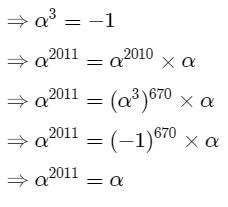


- a)9p/10
- b)5p/6
- c)6p/5
- d)none of these
Correct answer is option 'A'. Can you explain this answer?
a)
9p/10
b)
5p/6
c)
6p/5
d)
none of these

|
Lohit Matani answered |
sin(6π/5) + i(1+cos(6π/5)) or −sin(π/5) + i(1−cos(π/5)) lies in the second quadrant of complex plane hence its argument is given as
arg(x+iy) = π − tan-1 |y/x| (∀ x<0,y≥0)
= π−tan-1 |1−cos(π/5)/sin(π/5)|
= π−tan-1 |2sin2(π/10)/2sin(π/10)cos(π/10)|
= π−tan-1 |sin(π/10)/cos(π/10)|
= π − tan-1 |tan(π/10)|
= π−tan-1 (tan(π/10)) (∵ tan(π/10)>0)
= π−π/10(∵−π/2≤tan−1(x)≤π/2)
= 9π/10
arg(x+iy) = π − tan-1 |y/x| (∀ x<0,y≥0)
= π−tan-1 |1−cos(π/5)/sin(π/5)|
= π−tan-1 |2sin2(π/10)/2sin(π/10)cos(π/10)|
= π−tan-1 |sin(π/10)/cos(π/10)|
= π − tan-1 |tan(π/10)|
= π−tan-1 (tan(π/10)) (∵ tan(π/10)>0)
= π−π/10(∵−π/2≤tan−1(x)≤π/2)
= 9π/10
If z1 = 2 + i, z2 = 1 + 3i, then Re ( z1 - z2) =- a)ι
- b)1
- c)2 ι
- d)2
Correct answer is option 'B'. Can you explain this answer?
If z1 = 2 + i, z2 = 1 + 3i, then Re ( z1 - z2) =
a)
ι
b)
1
c)
2 ι
d)
2
|
|
Devika Roy answered |
The numbers in the questions are not very clear.
z1 = 2 + i
z2 = 1+3i
z1 – z2 = (2 – 1) + i (1 – 3)
= 1 – 2i
z1 = 2 + i
z2 = 1+3i
z1 – z2 = (2 – 1) + i (1 – 3)
= 1 – 2i
 then a and b are respectively :
then a and b are respectively :- a)64 and - 64√3
- b)128 and 128√3
- c)512 and - 512√3
- d)none of these
Correct answer is option 'C'. Can you explain this answer?
a)
64 and - 64√3
b)
128 and 128√3
c)
512 and - 512√3
d)
none of these
|
|
Om Desai answered |
(√3 + i)10 = a + ib
Z = √3 + i = rcosθ + i rsinθ
⇒ √3 = rcosθ i = rsinθ
⇒ (√3)2 + (1)2 = r2cos2θ + r2sin2θ
⇒ 4 = r2
⇒ r = 2
tan = 1/√3
⇒ tan π/6
Therefore, Z = √3 + i = 2(cos π/6 + i sin π/6)
(Z)10 = √3 + i = (2cos π/6 + 2i sin π/6)10
= 210 (cos π/6 + i sin π/6)10
210 (cos 10π/6 + i sin 10π/6)
= 210 (cos(2π - π/3) + i sin(2π - π/3))
= 210 (cos π/3 - i sin π/3)
= 210 (1/2 - i√3/2)
29(1 - i√3)
a = 29 = 512
b = - 29(√3) = -512√3
Z = √3 + i = rcosθ + i rsinθ
⇒ √3 = rcosθ i = rsinθ
⇒ (√3)2 + (1)2 = r2cos2θ + r2sin2θ
⇒ 4 = r2
⇒ r = 2
tan = 1/√3
⇒ tan π/6
Therefore, Z = √3 + i = 2(cos π/6 + i sin π/6)
(Z)10 = √3 + i = (2cos π/6 + 2i sin π/6)10
= 210 (cos π/6 + i sin π/6)10
210 (cos 10π/6 + i sin 10π/6)
= 210 (cos(2π - π/3) + i sin(2π - π/3))
= 210 (cos π/3 - i sin π/3)
= 210 (1/2 - i√3/2)
29(1 - i√3)
a = 29 = 512
b = - 29(√3) = -512√3
If points corresponding to the complex numbers z1, z2, z3 and z4 are the vertices of a rhombus, taken in order, then for a non-zero real number k- a)z1 – z3 = i k( z2 –z4)
- b)z1 – z2 = i k( z3 –z4)
- c)z1 + z3 = k( z2 +z4)
- d)z1 + z2 = k( z3 +z4)
Correct answer is option 'A'. Can you explain this answer?
If points corresponding to the complex numbers z1, z2, z3 and z4 are the vertices of a rhombus, taken in order, then for a non-zero real number k
a)
z1 – z3 = i k( z2 –z4)
b)
z1 – z2 = i k( z3 –z4)
c)
z1 + z3 = k( z2 +z4)
d)
z1 + z2 = k( z3 +z4)
|
|
Riya Banerjee answered |
AC = z3 = z1 eiπ
= z1 (cosπ + i sinπ)
= z3 = z1(-1 + i(0))
= z3 = -z1
AC = z1 - z3
BC = z2 - z4
(z1 - z3)/(z2 - z4) = k
(z1 - z3) = eiπ/2(z2 - z4)
(z1 - z3) k(cosπ/2 + sinπ/2) (z2 - z4)
z1 - z3 = ki(z2 - z4)
z1 - z3 = ik(z2 - z4)
= z1 (cosπ + i sinπ)
= z3 = z1(-1 + i(0))
= z3 = -z1
AC = z1 - z3
BC = z2 - z4
(z1 - z3)/(z2 - z4) = k
(z1 - z3) = eiπ/2(z2 - z4)
(z1 - z3) k(cosπ/2 + sinπ/2) (z2 - z4)
z1 - z3 = ki(z2 - z4)
z1 - z3 = ik(z2 - z4)
The value of (-1 + √-3)2 + (-1 - √-3)2 is
- a)8
- b)4
- c)-4
- d)-2
Correct answer is option 'C'. Can you explain this answer?
The value of (-1 + √-3)2 + (-1 - √-3)2 is
a)
8
b)
4
c)
-4
d)
-2

|
Learners Habitat answered |
The given expression can be simplified as follows:
-1 + √(-3) = -1 + i√3
-1 - √(-3) = -1 - i√3
Now, (-1 + i√3)2 = (-1)2 + 2*(-1)*(i√3) + (i√3)2
= 1 - 2i√3 - 3
= -2i√3 - 2
Similarly, (-1 - i√3)2 = (-1)2 + 2*(-1)*(-i√3) + (-i√3)2
= 1 + 2i√3 - 3
= 2i√3 - 2
Adding the two results together:
(-2i√3 - 2) + (2i√3 - 2) = -4
Therefore, the value of the expression is -4.
-1 + √(-3) = -1 + i√3
-1 - √(-3) = -1 - i√3
Now, (-1 + i√3)2 = (-1)2 + 2*(-1)*(i√3) + (i√3)2
= 1 - 2i√3 - 3
= -2i√3 - 2
Similarly, (-1 - i√3)2 = (-1)2 + 2*(-1)*(-i√3) + (-i√3)2
= 1 + 2i√3 - 3
= 2i√3 - 2
Adding the two results together:
(-2i√3 - 2) + (2i√3 - 2) = -4
Therefore, the value of the expression is -4.
If (1 – p) is root of quadratic equation x2 + px + (1 – p) = 0, then its roots are- a)0, 1
- b)–1, 1
- c)0, –1
- d)–1, 2
Correct answer is option 'C'. Can you explain this answer?
If (1 – p) is root of quadratic equation x2 + px + (1 – p) = 0, then its roots are
a)
0, 1
b)
–1, 1
c)
0, –1
d)
–1, 2
|
|
Anand Kumar answered |
Put (1-p) In the given equation and solve for p.
after solving it u will have two values of p
now, for the solution put values p one by one in (1-p)
after solving it u will have two values of p
now, for the solution put values p one by one in (1-p)
The set of all solutions of the inequality  < 1/4 contains the set
< 1/4 contains the set- a) (–¥, 0)
- b)(–¥, 1)
- c) (1, ¥)
- d) (3, ¥)
Correct answer is option 'D'. Can you explain this answer?
The set of all solutions of the inequality  < 1/4 contains the set
< 1/4 contains the set
a)
(–¥, 0)
b)
(–¥, 1)
c)
(1, ¥)
d)
(3, ¥)
|
|
Hansa Sharma answered |
(1/2)(x2 - 2x) < (1/4)
(1/2)(x2 - 2x) < (1/2)2
x2 − 2x > 2......(as after multiplicative inverse sign of inequality changes)
x2 − 2x − 2 > 0
x2 - 2x + 1 - 3 >
(x-1)2 - 3 > 0
(x-1)2 > 3
So for the above to hold good both the expression must be positive or both must be negative. After finding the solution the range of the solution will be
either x > 3
(3,¥)
(1/2)(x2 - 2x) < (1/2)2
x2 − 2x > 2......(as after multiplicative inverse sign of inequality changes)
x2 − 2x − 2 > 0
x2 - 2x + 1 - 3 >
(x-1)2 - 3 > 0
(x-1)2 > 3
So for the above to hold good both the expression must be positive or both must be negative. After finding the solution the range of the solution will be
either x > 3
(3,¥)

- a)0
- b)-1
- c)1
- d)none of these
Correct answer is option 'B'. Can you explain this answer?
a)
0
b)
-1
c)
1
d)
none of these
|
|
Parth Patel answered |
If it is -1 then it is given that the w is cube root of unity

- a)- i
- b)1
- c)i
- d)-1
Correct answer is option 'C'. Can you explain this answer?
a)
- i
b)
1
c)
i
d)
-1
|
|
Raghav Bansal answered |
x = (√3+i)/2
x3 = 1/8(√3+i)3
Apply formula (a+b)3 = a3 + b3 + 3a2b + 3ab2
= (3√3 + i3 + 3*3*i + 3*√3*i2)/8
= (3√3 - i + 9i - 3√3)/8
= 8i/8
= i
x3 = 1/8(√3+i)3
Apply formula (a+b)3 = a3 + b3 + 3a2b + 3ab2
= (3√3 + i3 + 3*3*i + 3*√3*i2)/8
= (3√3 - i + 9i - 3√3)/8
= 8i/8
= i
Numbers of values of k for which roots of equation x2 − 3x + k = 0 lie in the interval (0,1) is- a)only one
- b)no value
- c)finite but more than one
- d)k ≤ 9/4
Correct answer is option 'B'. Can you explain this answer?
Numbers of values of k for which roots of equation x2 − 3x + k = 0 lie in the interval (0,1) is
a)
only one
b)
no value
c)
finite but more than one
d)
k ≤ 9/4

|
Pragati Choudhury answered |
Understanding the Quadratic Equation
The given quadratic equation is x² - 3x + k = 0. We need to determine the values of k for which the roots of this equation lie within the interval (0,1).
Condition for Roots in Interval (0,1)
For the roots of a quadratic equation ax² + bx + c = 0 to lie in an interval (a, b), the following conditions must be satisfied:
1. Sum of Roots: The sum of the roots (r1 + r2) = -b/a should be greater than 0 and less than 2.
2. Product of Roots: The product of the roots (r1 * r2) = c/a should be greater than 0.
In our case:
- Sum of Roots: r1 + r2 = 3
- Product of Roots: r1 * r2 = k
Analyzing the Conditions
1. Sum of Roots: Since 3 is not in the interval (0, 2), the first condition fails. This implies that the roots cannot both be positive and less than 1.
2. Product of Roots: For the product k to be positive, k must be greater than 0. However, this doesn’t help as the sum condition already invalidates the possibility of the roots lying in (0,1).
Conclusion
Given that the sum of the roots is fixed at 3, which does not allow both roots to lie within (0,1), we conclude that:
- There are no values of k that satisfy the conditions for the roots to lie in the interval (0,1).
Thus, the correct answer is option B: no value.
The given quadratic equation is x² - 3x + k = 0. We need to determine the values of k for which the roots of this equation lie within the interval (0,1).
Condition for Roots in Interval (0,1)
For the roots of a quadratic equation ax² + bx + c = 0 to lie in an interval (a, b), the following conditions must be satisfied:
1. Sum of Roots: The sum of the roots (r1 + r2) = -b/a should be greater than 0 and less than 2.
2. Product of Roots: The product of the roots (r1 * r2) = c/a should be greater than 0.
In our case:
- Sum of Roots: r1 + r2 = 3
- Product of Roots: r1 * r2 = k
Analyzing the Conditions
1. Sum of Roots: Since 3 is not in the interval (0, 2), the first condition fails. This implies that the roots cannot both be positive and less than 1.
2. Product of Roots: For the product k to be positive, k must be greater than 0. However, this doesn’t help as the sum condition already invalidates the possibility of the roots lying in (0,1).
Conclusion
Given that the sum of the roots is fixed at 3, which does not allow both roots to lie within (0,1), we conclude that:
- There are no values of k that satisfy the conditions for the roots to lie in the interval (0,1).
Thus, the correct answer is option B: no value.
If difference between the roots ofthe equation x2 – kx + 8 = 0 is 4 then the value of K is: - a)0
- b)±4
- c)±8√3
- d)±4√3
Correct answer is option 'D'. Can you explain this answer?
If difference between the roots ofthe equation x2 – kx + 8 = 0 is 4 then the value of K is:
a)
0
b)
±4
c)
±8√3
d)
±4√3

|
Nipuns Institute answered |
let α, β are roots of x2 – kx + 8 = 0
∴ α + β = -b/a = −(−k)/1 = k & α. β = c/a = 8/1 = 8
(α – β)2 = (α + β)2 – 4αβ = 42
⇒ k2 – 4 × 8 = 16
or k2 = 48 ⇒ k = ±√16×3 ⇒ k = ±4√3
(d) is correct.
∴ α + β = -b/a = −(−k)/1 = k & α. β = c/a = 8/1 = 8
(α – β)2 = (α + β)2 – 4αβ = 42
⇒ k2 – 4 × 8 = 16
or k2 = 48 ⇒ k = ±√16×3 ⇒ k = ±4√3
(d) is correct.
If the roots of the equation kx2 – 3x -1= 0 are the reciprocal of the roots of the equation x2 + 3x – 4 = 0 then K =- a)4
- b)-4
- c)3
- d)-3
Correct answer is option 'A'. Can you explain this answer?
If the roots of the equation kx2 – 3x -1= 0 are the reciprocal of the roots of the equation x2 + 3x – 4 = 0 then K =
a)
4
b)
-4
c)
3
d)
-3

|
KP Classes answered |
∵ x2 + 3x – 4 = 0
or; x2 – 4x + x – 4 = 0
or; x(x – 4) + 1(x – 4) = 0
or; (x – 4)(x + 1) = 0
x = 4; -1
Eqn. having roots 1/2 & 1/−1 = 1/4 & – 1 is.
or x2 – (1/4 – 1) + 1/4(-1) = 0
or x2 + 3/4x – 1/4 = 0
Multiplying by 4 ; we get
4x2 + 3x -1 = 0
Comparing it with kx2 + 3x -1 = 0
We get K = 4
Tricks : Eqn. having roots the reciprocal of the roots of ax2 + bx + c = 0 is cx2 + bx +a = 0 i.e. 1st and last term interchanges.
or; x2 – 4x + x – 4 = 0
or; x(x – 4) + 1(x – 4) = 0
or; (x – 4)(x + 1) = 0
x = 4; -1
Eqn. having roots 1/2 & 1/−1 = 1/4 & – 1 is.
or x2 – (1/4 – 1) + 1/4(-1) = 0
or x2 + 3/4x – 1/4 = 0
Multiplying by 4 ; we get
4x2 + 3x -1 = 0
Comparing it with kx2 + 3x -1 = 0
We get K = 4
Tricks : Eqn. having roots the reciprocal of the roots of ax2 + bx + c = 0 is cx2 + bx +a = 0 i.e. 1st and last term interchanges.
If z = x + yi ; x ,y ∈ R, then locus of the equation  , where c ∈ R and b ∈ C, b ≠ 0 are fixed, is
, where c ∈ R and b ∈ C, b ≠ 0 are fixed, is- a)a parabola
- b)a straight line
- c)a circle
- d)none of these
Correct answer is option 'B'. Can you explain this answer?
If z = x + yi ; x ,y ∈ R, then locus of the equation  , where c ∈ R and b ∈ C, b ≠ 0 are fixed, is
, where c ∈ R and b ∈ C, b ≠ 0 are fixed, is
a)
a parabola
b)
a straight line
c)
a circle
d)
none of these
|
|
Vivek answered |
As b and c are linear constants ,independent of x and y, then by substituting them in the equation given, we get an equation linear in x and y. Thus, the given equation represents a straight line.
If coefficients of the equation ax2 + bx + c = 0, a < 0 are real and roots of the equation are non–real complex and a + c + b < 0, then- a)4a + c < 2b
- b)4a + c> 2b
- c)4a + c = 2b
- d)none of these
Correct answer is option 'A'. Can you explain this answer?
If coefficients of the equation ax2 + bx + c = 0, a < 0 are real and roots of the equation are non–real complex and a + c + b < 0, then
a)
4a + c < 2b
b)
4a + c> 2b
c)
4a + c = 2b
d)
none of these

|
Arindam Unni answered |
Method to Solve
Puting x=-1
a-b+c
but
a+c<b or a+c-b<0
hence f(x)<0 for all real values of x
therefore
putting x=-2
we get f(X)=4a+c-2b<0
or 4a+c<2b
a-b+c
but
a+c<b or a+c-b<0
hence f(x)<0 for all real values of x
therefore
putting x=-2
we get f(X)=4a+c-2b<0
or 4a+c<2b
i2+i4+i6+........... up to 2k + 1 terms, for all k belongs to natural numbers N.- a)1
- b)-1
- c)0
- d)none of these
Correct answer is option 'B'. Can you explain this answer?
i2+i4+i6+........... up to 2k + 1 terms, for all k belongs to natural numbers N.
a)
1
b)
-1
c)
0
d)
none of these
|
|
Meghana Pillai answered |
To solve this problem, we need to find the sum of the series i2 i4 i6 ...........up to 2k 1 terms, for all k belongs to natural numbers N.
Let's break down the given series and analyze it step by step.
Step 1: Simplifying the series
The given series can be written as:
i^2 + i^4 + i^6 + ... + (2k)^2
Step 2: Identifying the pattern
We can see that each term in the series is of the form i^(2n), where n is a positive integer.
Step 3: Finding the sum of the series
The sum of a series in the form of a geometric progression can be found using the formula:
S = a * (r^n - 1) / (r - 1)
In this case, the first term (a) is i^2, the common ratio (r) is i^2, and the number of terms (n) is k.
So, the sum of the series can be written as:
S = i^2 * (i^2)^k - 1 / (i^2 - 1)
Step 4: Simplifying the expression
Using the laws of exponents, we can simplify the expression further:
S = i^2 * i^2k - 2 / (i^2 - 1)
S = i^(2 + 2k - 2) / (i^2 - 1)
S = i^(2k) / (i^2 - 1)
Step 5: Evaluating the sum for all k belongs to natural numbers N
Since i is the imaginary unit, i^2 = -1. Substituting this value into the expression, we get:
S = (-1)^k / (-1 - 1)
S = (-1)^k / (-2)
S = (-1)^(k-1) / 2
Step 6: Determining the answer
The sum of the series (-1)^(k-1) / 2 is (-1)^(k-1) divided by 2.
Since the sum of the series is -1/2 for all k belongs to natural numbers N, the correct answer is option 'B' (-1).
Let's break down the given series and analyze it step by step.
Step 1: Simplifying the series
The given series can be written as:
i^2 + i^4 + i^6 + ... + (2k)^2
Step 2: Identifying the pattern
We can see that each term in the series is of the form i^(2n), where n is a positive integer.
Step 3: Finding the sum of the series
The sum of a series in the form of a geometric progression can be found using the formula:
S = a * (r^n - 1) / (r - 1)
In this case, the first term (a) is i^2, the common ratio (r) is i^2, and the number of terms (n) is k.
So, the sum of the series can be written as:
S = i^2 * (i^2)^k - 1 / (i^2 - 1)
Step 4: Simplifying the expression
Using the laws of exponents, we can simplify the expression further:
S = i^2 * i^2k - 2 / (i^2 - 1)
S = i^(2 + 2k - 2) / (i^2 - 1)
S = i^(2k) / (i^2 - 1)
Step 5: Evaluating the sum for all k belongs to natural numbers N
Since i is the imaginary unit, i^2 = -1. Substituting this value into the expression, we get:
S = (-1)^k / (-1 - 1)
S = (-1)^k / (-2)
S = (-1)^(k-1) / 2
Step 6: Determining the answer
The sum of the series (-1)^(k-1) / 2 is (-1)^(k-1) divided by 2.
Since the sum of the series is -1/2 for all k belongs to natural numbers N, the correct answer is option 'B' (-1).
If i2=−1, then sum i+i2+i3+....... to 1000 terms is equal to
- a)1
- b)0
- c)-1
- d)none of these
Correct answer is option 'B'. Can you explain this answer?
If i2=−1, then sum i+i2+i3+....... to 1000 terms is equal to
a)
1
b)
0
c)
-1
d)
none of these
|
|
Mahi Pillai answered |
Sum of arithmetic series:
The given sequence is an arithmetic series with a common difference of 1. Let's denote the first term as 'a' and the number of terms as 'n'. The sum of an arithmetic series can be calculated using the formula:
Sn = (n/2)(2a + (n-1)d)
Where Sn is the sum of the series, a is the first term, n is the number of terms, and d is the common difference.
Calculating the sum:
In this case, the first term 'a' is 1 and the common difference 'd' is also 1. So, the formula becomes:
Sn = (n/2)(2 + n - 1)
Simplifying further:
Sn = (n/2)(n + 1)
Now, let's substitute the given value of 'n' and calculate the sum:
S4n = (4n/2)(4n + 1)
S4n = 2n(4n + 1)
S4n = 8n^2 + 2n
Determining the sum's value:
To find the value of the sum, we need to substitute the value of 'n' into the equation. However, since the options are not expressed in terms of 'n', we can do some algebraic manipulation to simplify the expression further.
Let's factor out n from the equation:
S4n = n(8n + 2)
We can see that 'n' is a common factor in both terms. Since 'n' represents the number of terms, it is always a positive value. Therefore, the sum can only be zero when '8n + 2' equals zero.
Setting '8n + 2' equal to zero and solving for 'n':
8n + 2 = 0
8n = -2
n = -2/8
Since 'n' represents the number of terms, it cannot be a negative value. Therefore, there is no value of 'n' for which the sum is zero. Hence, the correct answer is option 'B' - 0.
Conclusion:
The sum of the given arithmetic series is equal to zero.
The given sequence is an arithmetic series with a common difference of 1. Let's denote the first term as 'a' and the number of terms as 'n'. The sum of an arithmetic series can be calculated using the formula:
Sn = (n/2)(2a + (n-1)d)
Where Sn is the sum of the series, a is the first term, n is the number of terms, and d is the common difference.
Calculating the sum:
In this case, the first term 'a' is 1 and the common difference 'd' is also 1. So, the formula becomes:
Sn = (n/2)(2 + n - 1)
Simplifying further:
Sn = (n/2)(n + 1)
Now, let's substitute the given value of 'n' and calculate the sum:
S4n = (4n/2)(4n + 1)
S4n = 2n(4n + 1)
S4n = 8n^2 + 2n
Determining the sum's value:
To find the value of the sum, we need to substitute the value of 'n' into the equation. However, since the options are not expressed in terms of 'n', we can do some algebraic manipulation to simplify the expression further.
Let's factor out n from the equation:
S4n = n(8n + 2)
We can see that 'n' is a common factor in both terms. Since 'n' represents the number of terms, it is always a positive value. Therefore, the sum can only be zero when '8n + 2' equals zero.
Setting '8n + 2' equal to zero and solving for 'n':
8n + 2 = 0
8n = -2
n = -2/8
Since 'n' represents the number of terms, it cannot be a negative value. Therefore, there is no value of 'n' for which the sum is zero. Hence, the correct answer is option 'B' - 0.
Conclusion:
The sum of the given arithmetic series is equal to zero.
Let x,y ∈ R, hen x + iy is a non real complex number if- a)y = 0
- b)x ≠ 0
- c)x = 0
- d)y ≠ 0
Correct answer is option 'D'. Can you explain this answer?
Let x,y ∈ R, hen x + iy is a non real complex number if
a)
y = 0
b)
x ≠ 0
c)
x = 0
d)
y ≠ 0
|
|
Muskaan Chakraborty answered |
I'm sorry, but your question is incomplete. Please provide more information or specify what you would like me to do.

- a)24i
- b)24
- c)-24
- d)-24i
Correct answer is option 'D'. Can you explain this answer?
a)
24i
b)
24
c)
-24
d)
-24i
|
|
Preeti Iyer answered |
√-8 * √-18 * √-4
= 2√2(√-1) × 3√2(√-1) × 2(√-1)
= 2√2(i) × 3√2(i) × 2(i)
= (2√2 * 3√2 * 2) *(i * i * i)
= (24)(-i2 * i)
= 24(-i)
= -24i
= 2√2(√-1) × 3√2(√-1) × 2(√-1)
= 2√2(i) × 3√2(i) × 2(i)
= (2√2 * 3√2 * 2) *(i * i * i)
= (24)(-i2 * i)
= 24(-i)
= -24i

- a)none of these
- b)a circle
- c)a straight line
- d)an ellipse
Correct answer is option 'B'. Can you explain this answer?
a)
none of these
b)
a circle
c)
a straight line
d)
an ellipse
|
|
Geetika Shah answered |
 This is Equation of a Circle.
This is Equation of a Circle.The value of p and q(p ≠ 0,q ≠ 0) for which p, q are the roots of the equation x2 + px + q = 0 are- a)p = 1,q = 2
- b)p = −1,q = 2
- c)p = −1, q = −2
- d)p = 1,q = −2
Correct answer is option 'D'. Can you explain this answer?
The value of p and q(p ≠ 0,q ≠ 0) for which p, q are the roots of the equation x2 + px + q = 0 are
a)
p = 1,q = 2
b)
p = −1,q = 2
c)
p = −1, q = −2
d)
p = 1,q = −2

|
KP Classes answered |
Sum of the roots = p + q = −p and product of the roots pq = q
∴ p = 1 [q ≠ 0]
∴1 + q = −1 ⇒ q = −2
∴ p = 1,q = −2
∴ p = 1 [q ≠ 0]
∴1 + q = −1 ⇒ q = −2
∴ p = 1,q = −2
Arg. (x) , x ∈ R and x < 0 is- a)3π/2
- b)0
- c)π
- d)π/2
Correct answer is option 'C'. Can you explain this answer?
Arg. (x) , x ∈ R and x < 0 is
a)
3π/2
b)
0
c)
π
d)
π/2

|
Anushka Desai answered |
Arg(x) = Arg (x + 0i)
Since x < 0, x lies alongside the negative X – axis.
tan(θ) = 0 and the point lies on negative X – axis
So, θ = π
Since x < 0, x lies alongside the negative X – axis.
tan(θ) = 0 and the point lies on negative X – axis
So, θ = π
Chapter doubts & questions for Complex Numbers & Quadratic Equations - Mathematics (Maths) Class 11 2025 is part of Commerce exam preparation. The chapters have been prepared according to the Commerce exam syllabus. The Chapter doubts & questions, notes, tests & MCQs are made for Commerce 2025 Exam. Find important definitions, questions, notes, meanings, examples, exercises, MCQs and online tests here.
Chapter doubts & questions of Complex Numbers & Quadratic Equations - Mathematics (Maths) Class 11 in English & Hindi are available as part of Commerce exam.
Download more important topics, notes, lectures and mock test series for Commerce Exam by signing up for free.
Mathematics (Maths) Class 11
73 videos|264 docs|91 tests
|

Contact Support
Our team is online on weekdays between 10 AM - 7 PM
Typical reply within 3 hours
|
Free Exam Preparation
at your Fingertips!
Access Free Study Material - Test Series, Structured Courses, Free Videos & Study Notes and Prepare for Your Exam With Ease

 Join the 10M+ students on EduRev
Join the 10M+ students on EduRev
|

|
Create your account for free
OR
Forgot Password
OR
Signup on EduRev and stay on top of your study goals
10M+ students crushing their study goals daily
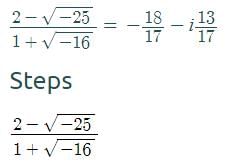
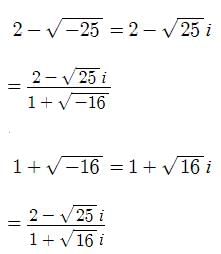




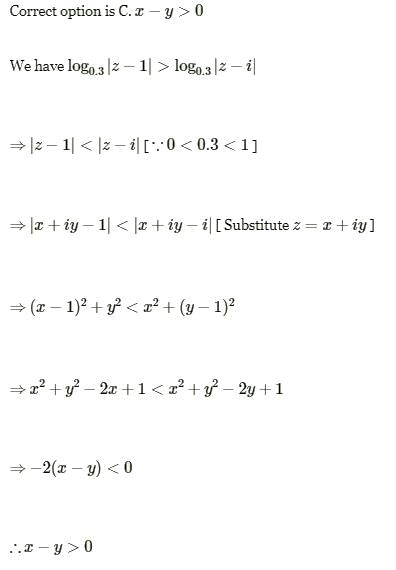 =
=
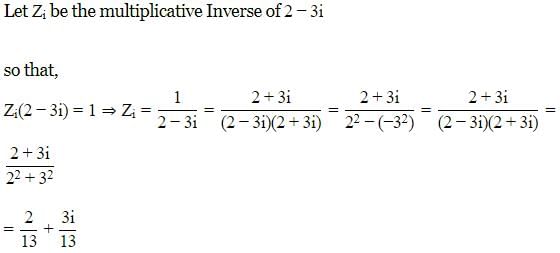
 then z69 is equal to :
then z69 is equal to :
